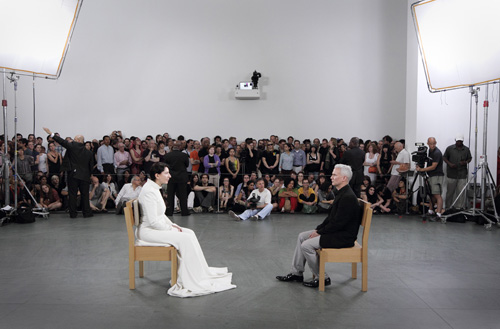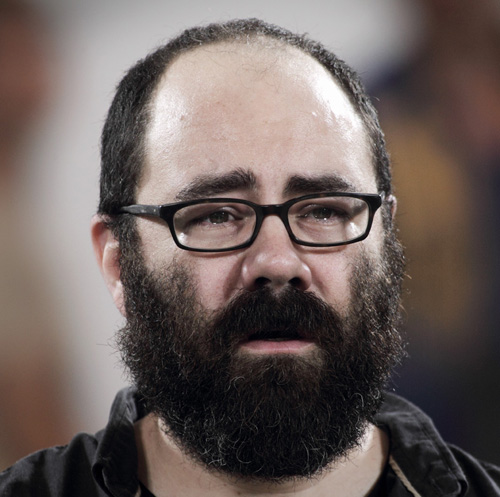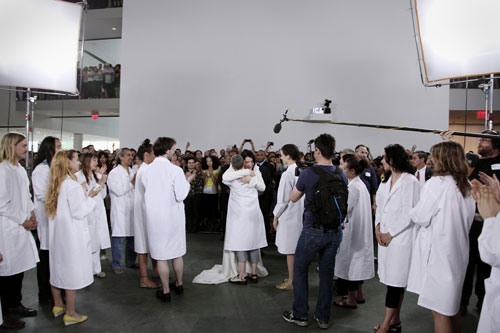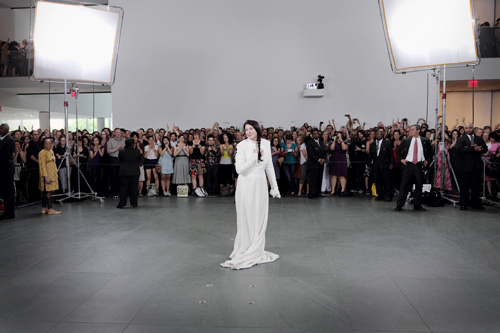Culture Zohn Off the C(H)uff: Marina Abramovic Is Present

Photographs by Marco Anelli
Marina Abramovic finally ended her three-month long marathon The Artist is Present peformance piece at the Museum of Modern Art on Monday. There has been a dinner celebrating her and a symposium which began the debriefing process she considers integral to the work.
There has been much chatter and much written about her solo performance as well as the performers she had engaged to re-perform her work in the exhibition devoted to her in the galleries above. I found the retrospective exhilarating, instructive and alternately high-spirited and heartbreaking. Abramovic takes herself seriously and is undeterred by the naysayers around her. For this quality and her creativity, I have a great deal of admiration.
Abramovic--clearly eager to depart for the countryside and sounding exhausted and emotional--nevertheless took a few minutes to speak with me about her experiences.
CZ: After 700 hours of stillness, even though you did have nights to move around, what was the thing you found most challenging as you completed this piece?
MA: To go back to the normality of life. Because I thought [while it was underway], how I could survive this was with a system of eating and exercises, special things to deal with the pain. There was a system: I go to the MoMA and then I'm in a zone, and I come back afterward. It's been going like this for three months: I started in the winter and finished in the summer. It becomes some kind of system of life--and then breaking this and confronting especially the last day with this audience which has been looking for days in my eyes [over the Memorial Day weekend] and then start talking to them, it was quite a shock. It is very difficult to adjust.I am going to the countryside. Just being in the fresh air, after three months of artificial light! The shock is to go back to normality.
CZ: What was the most frightening moment?MA: It's not something frightening exactly, but really how to deal with the pain which was very extensive especially in April. April was extremely difficult for me because there were five Fridays in April, and ten hours each day. It was really extremely difficult. I really had the fear of how to deal with the pain.CZ: You have trained yourself and the other performers to be able to be able to be still. Yet some of your most original and clearly ground-breaking performance pieces began in repetitive movement. The journey from movement to stillness seems to have culminated in this piece. Has there been a parallel spiritual path?MA: There has been evolution in my work. In the beginning I was very much busy with the physical body and the limits of the physical body but that somehow naturally led me to the mental body and how I could deal with that. Stillness is so much harder, especially for three months. It was a big challenge. As a performer it is the most difficult experience one can have. And the interactive experience with the public made it even harder.CZ: I saw Ulay [Abramovic's former longtime partner in life and work] go up to sit opposite you on opening night. You appeared to be moved. Were you?MA: With Ulay we had long history of living together and being together--twelve years. Finally, we split on the wall in China. We had done a piece where we sat at a table, so this piece was an extension of that--and that was very important. When he came and sat it was a very historical moment--somehow closing the circle and closing one period of my life.CZ: Were there other sitters that you remember vividly or who stood out above the pack who challenged or affected you and why?MA: I looked into something like 1,564 pairs of eyes! It's amazing the memory of these people; they are still stuck in my head, especially anyone who sat longer than 20 minutes. So I created some kind of family with these people. People came back and back, there was a man who came 31 times a woman who came 30 times.
There was a very big man who came once who was like a biker, looking very angry and suspicious. Finally he was looking like a baby, crying, his whole body shaking. It was really a shock with that man how so much pain he had and it was like someone opened the cork of his heart and he had an eruption of emotion that he could not hold in. If you sit in that chair and look at me after a while I am like the mirror of your own self-experience.CZ: The exhibition was an eye-opener on so many levels. People who had never before experienced performance art were literally thrust into understanding the complex feelings and thoughts it can elicit. Though you did not participate upstairs in the exhibition galleries, what was the reaction and feedback you got from your performers? Do you think that with the internet making this imagery available--and now the imprimatur of the Museum of Modern Art--that this might have been a breakthrough to another level of awareness as to the seriousness of performance art as a discipline like painting or sculpture?
MA: It's true that I never got to go upstairs, which is quite incredible! You have to put your ego away and you have to trust these people, you lose control of your own piece. But I believe more than ever that performance art has to be reperformed even if the performer changes the concept because of his own charisma. Still, even though it is different, it is better for it to be performed that way then not to be performed at all. At the symposium it was incredible how articulate and clear the re-performers were, it was quite amazing to listen to their experiences. We will have a book coming out with their experiences, my experience, and the public experiences. It is very important that Marco Anelli, the photographer, spent so much time and energy on a one to one basis, to be present as long as someone occupied that seat facing me.So: the artist is present, the public is present and the photographer is present.CZ: You aim to create an biographical work with Robert Wilson. Will you perform in your own biography or will you cast someone else? What precisely is the nature of the collaboration? And do you envision this work going up in a theater or in a museum. In other words, what kind of art animal is it?MA: The biography has been performed since 1989. Every four or five years I ask a theater director to do my life and I give unconditional control to the director. The directors have the authority to mix my life the way they want. It's the Life and Death of Marina Abramovic with the funeral on the stage. There will be performance artists and me. It will premiere at the Manchester International Festival in July 2011, and then will be touring.
Welcome back, Marina Abramovic!
From the Huffington Post, here.





0 comments:
Post a Comment